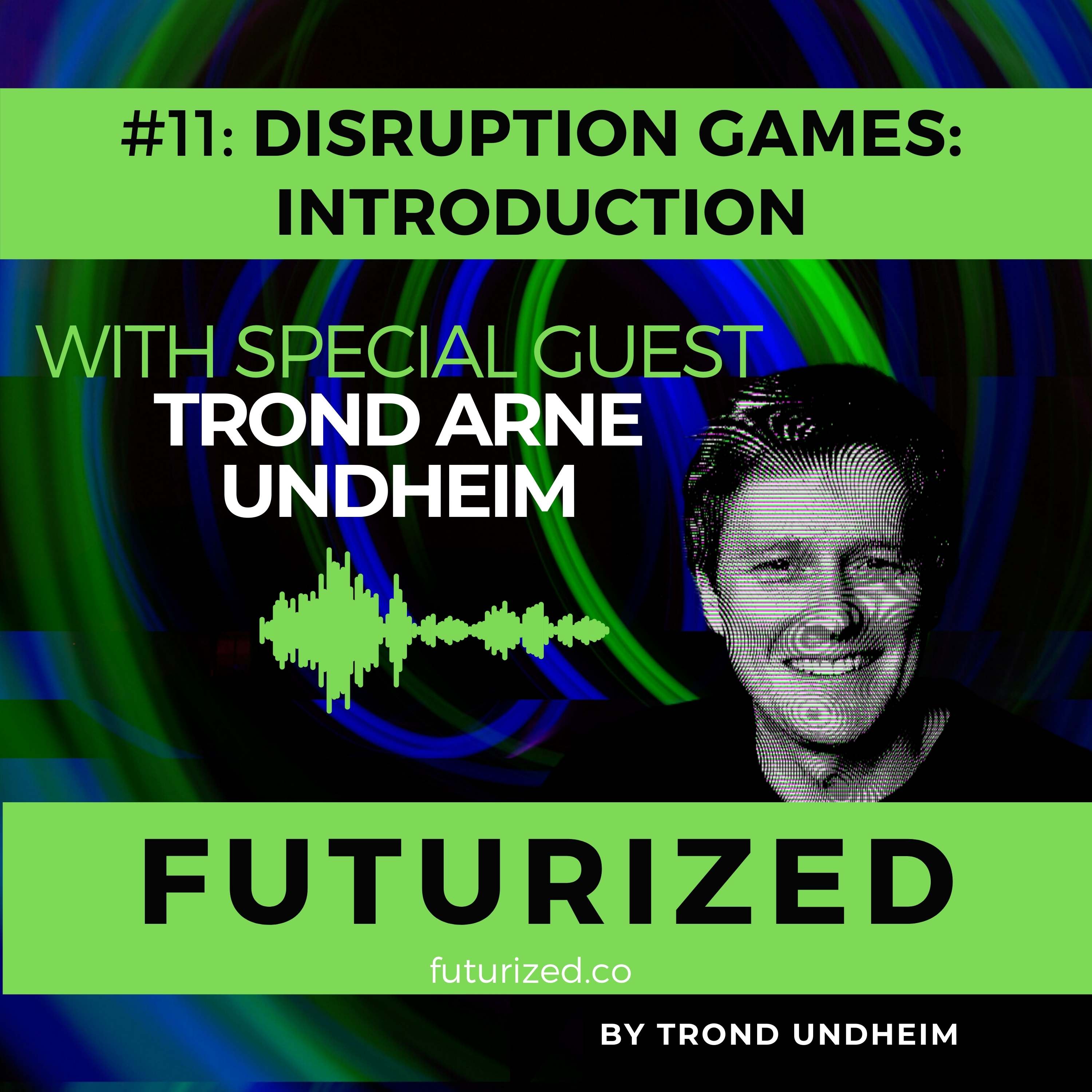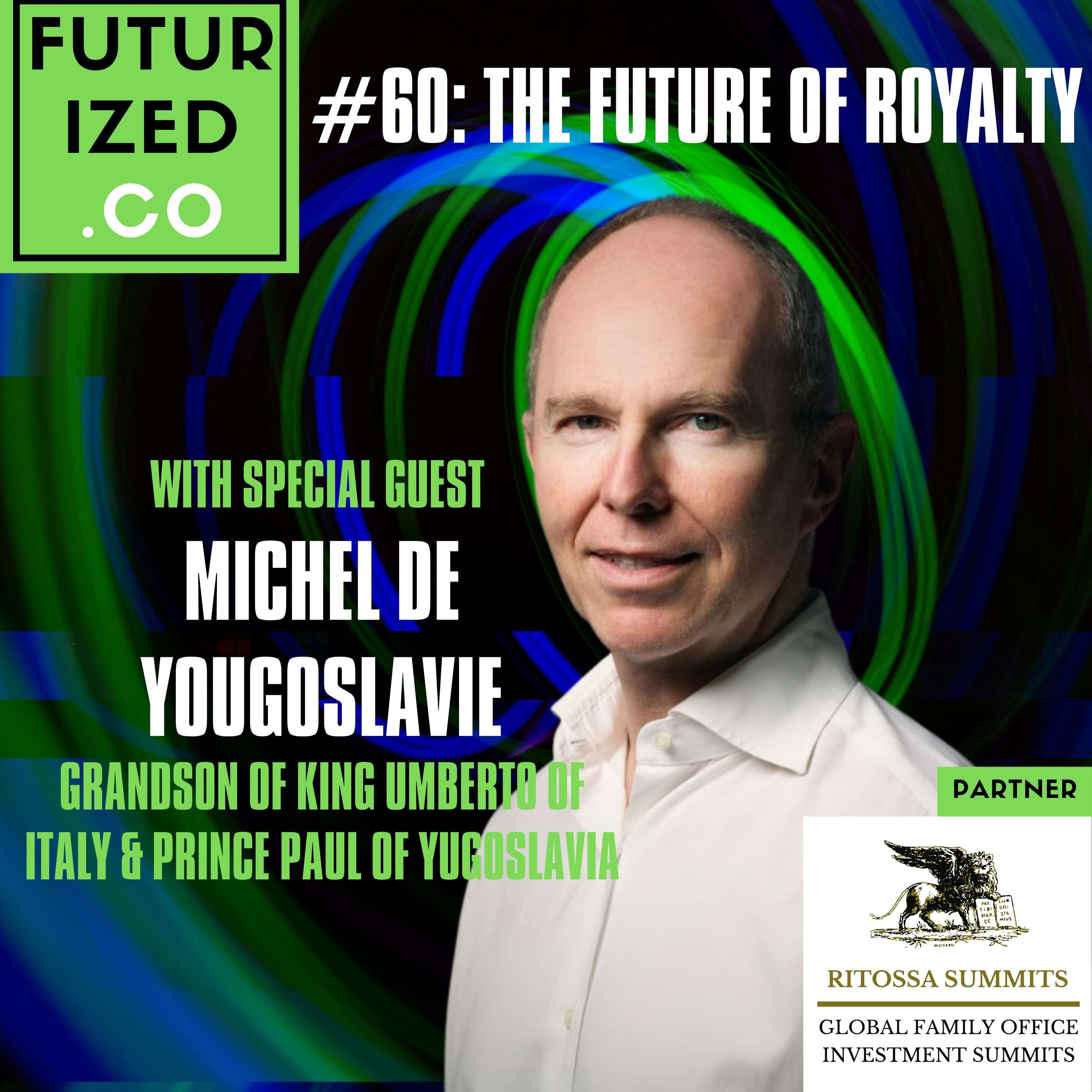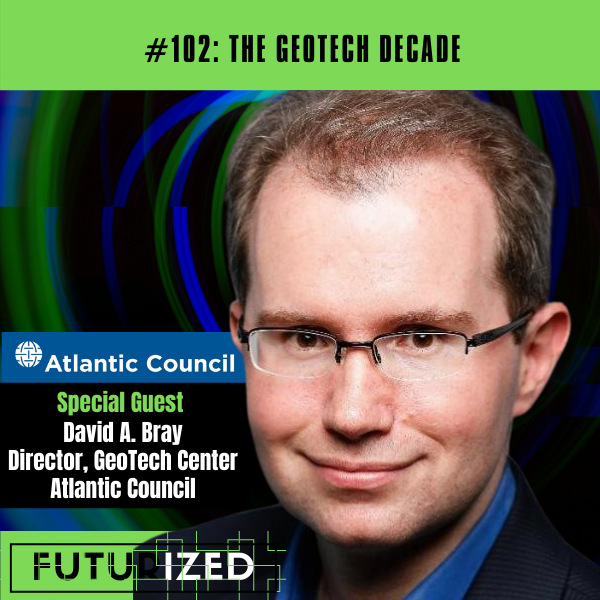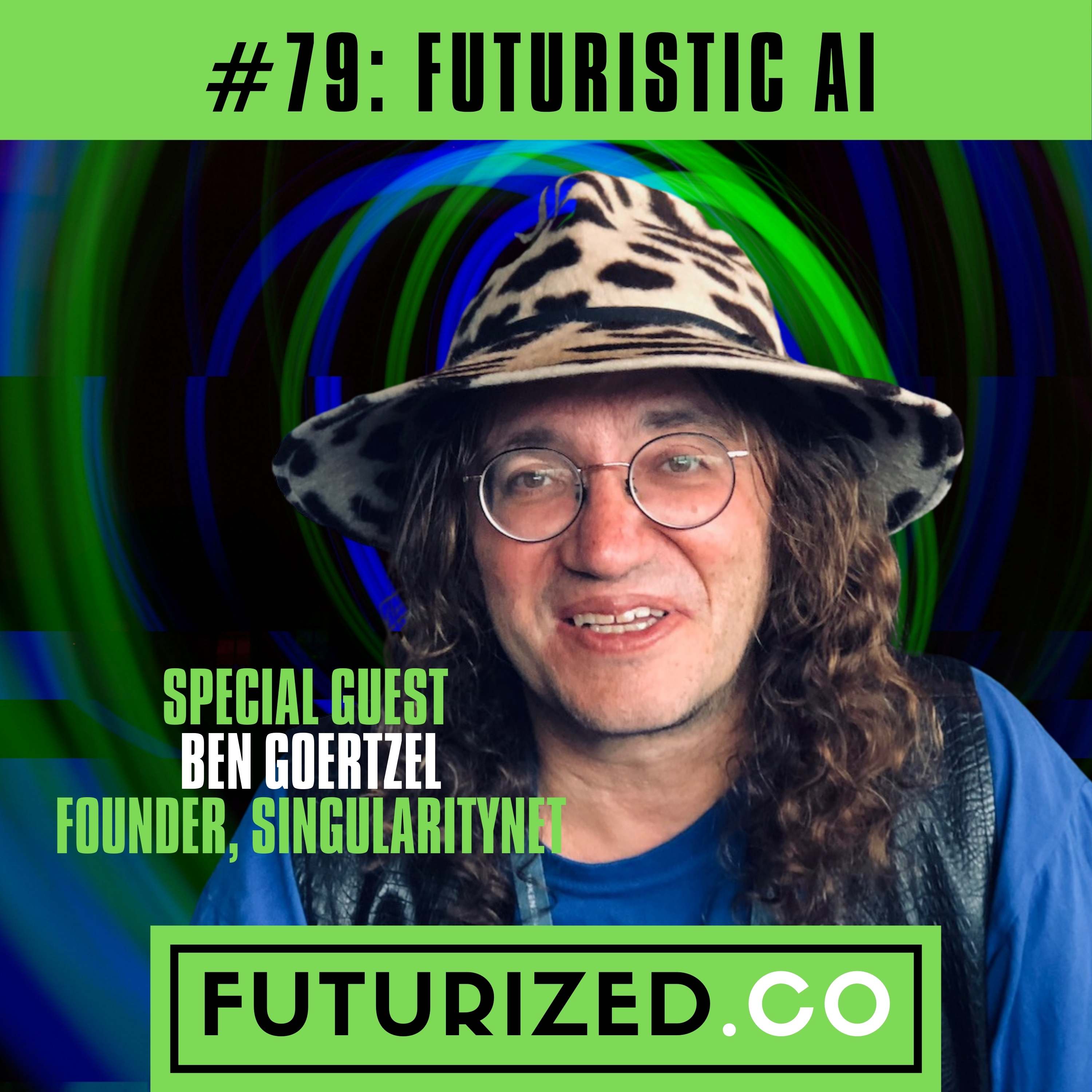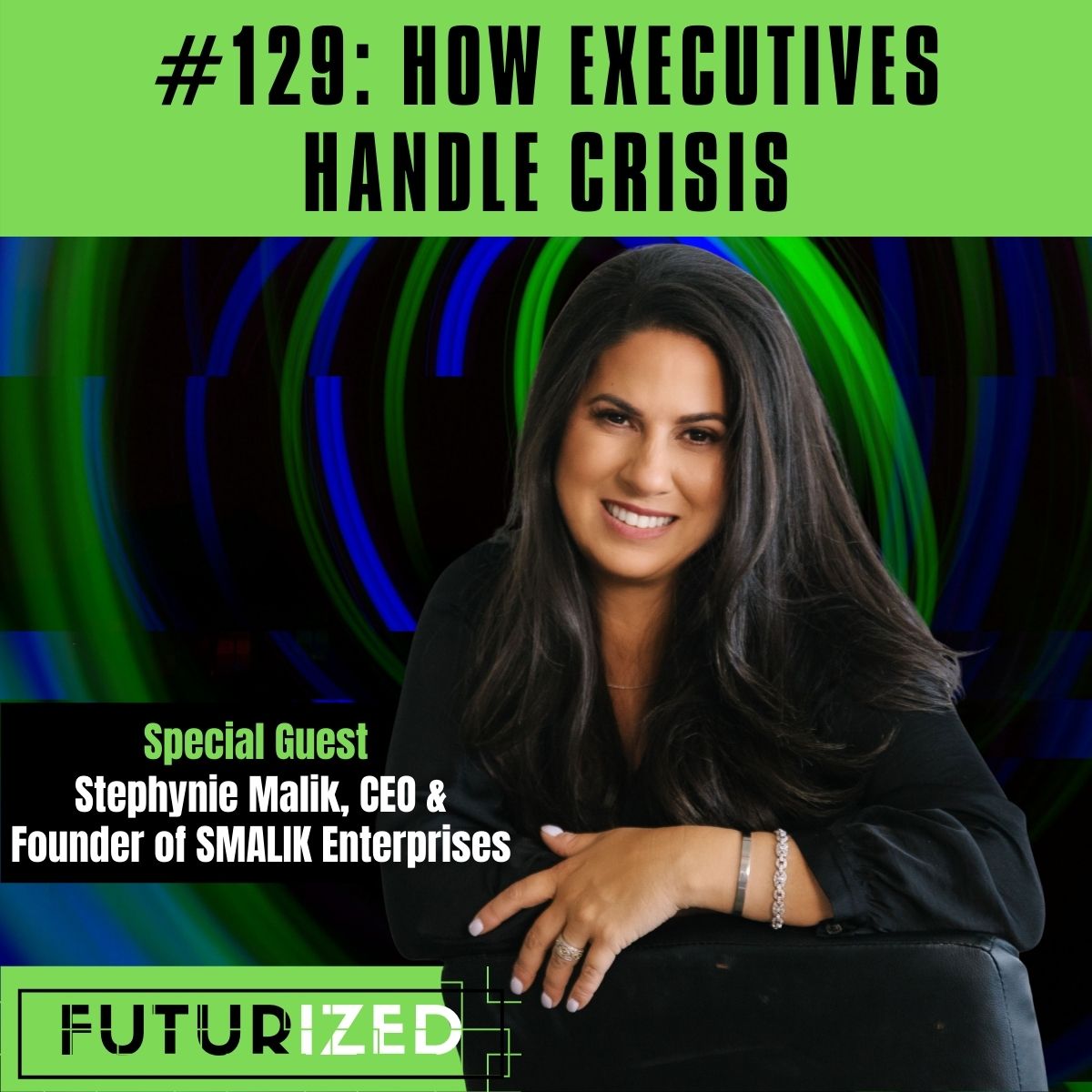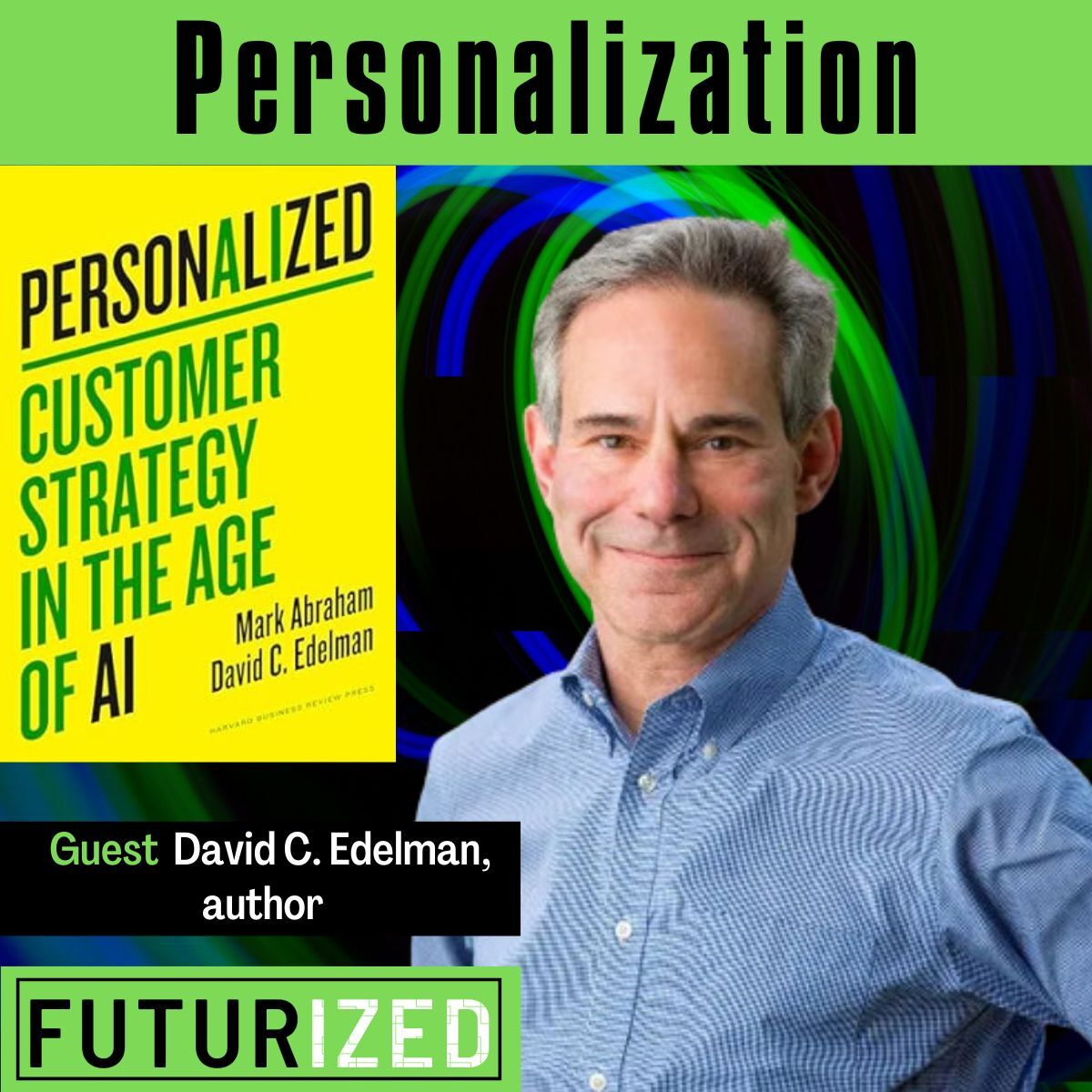Industrial-grade Mixed Reality
Urho Konttori, co-founder and Chief Innovation Officer of Varjo, the mixed reality equipment maker, interviewed by futurist Trond Arne Undheim.
In this conversation, they talk about The Future of Industrial-grade Mixed Reality (MR). The advent of ente...
Urho Konttori, co-founder and Chief Innovation Officer of Varjo, the mixed reality equipment maker, interviewed by futurist Trond Arne Undheim.
In this conversation, they talk about The Future of Industrial-grade Mixed Reality (MR). The advent of enterprise/industrial-grade AR/VR/XR/MR/hybrid reality and its impact on RR. Which companies are using it already? Current professional user types. Emerging use cases. Why is Varjo so focused on human-eye resolution devices and hi-res MR? We discuss adoption timelines and formfactors as well as remaining technical/market challenges. We look into the Future of mixed reality (5-10 years ahead).
The takeaway is that industrial mixed reality has now come of age. It is only a question of few years, until large swaths of industry and a plethora of professionals will depend on it to do their job. The pandemic could not have come at a bigger inflection point for the industry.
After listening to this episode, check out Varjo as well as Urho Konttori's online profile:
- Varjo https://varjo.com/
- Urho Konttori (@konttori) https://www.linkedin.com/in/urho-konttori-aa16835/
The show is hosted by Podbean and can be found at Futurized.co. Additional context about the show, the topics, and our guests, including show notes and a full list of podcast players that syndicate the show can be found at https://trondundheim.com/podcast/. Music: Electricity by Ian Post from the album Magnetism.
For more about the host, including media coverage, books and more, see Trond Arne Undheim's personal website (https://trondundheim.com/) as well as the Yegii Insights blog (https://yegii.wpcomstaging.com/). Undheim has published two books this year, Pandemic Aftermath and Disruption Games. To advertise or become a guest on the show, contact the podcast host here.
Thanks for listening. If you liked the show, subscribe at Futurized.co or in your preferred podcast player, and rate us with five stars. If you like this topic, you may enjoy other episodes of Futurized, such as episode 30 on Artificial General Intelligence, episode 51 which is on the AI for Learning, episode 16 on Perception AI, episode 49 Living the Future of Work, episode 35 on How 5G+AR might revolutionize communication, episode 47 on How to Invest in Sci-Fi Tech, episode 54 on the Future of AR, and episode 31 on The Future of Commoditized Robotics. Futurized—preparing YOU to deal with disruption.
Industrial MR_mixdown
Trond Arne Undheim, Host: [00:00:00] Futurized goes beneath the trends to track the underlying forces of disruption in tech policy, business models, social dynamics, and the environment. I'm your host thrown on even hype, futurist and author in episode 68 of the podcast, the topic is industrial grade mixed reality. Our guest is Earl contour co-founder and chief product officer Avario.
[00:00:26] The mixed reality equipment leaker in this conversation, we talk about the future of industrial grade mixed reality. Or Mr. We talk about the advent of enterprise, a R V R X, R M R, and or hybrid reality and its impact on RR important, real reality, which companies are using it already. Current practice, national user types and emerging use case.
[00:00:56] And why is Vario so focused on human eye resolution devices and Jairus? Mr. We discussed adoption timelines and four factors as well as remaining technical and market challenges. We look into the future of mixed reality, five to 10 years ahead.
[00:01:15] Urho Konttori, Co-founder, Varjo: [00:01:15] How are you today? I'm really good. It's been a fantastic day here in Helsinki and yeah, about to Take it off for the rest of the day soon.
[00:01:24] Trond Arne Undheim, Host: [00:01:24] All right. So I'm super excited to be talking about all things future with you. You are now working for Vario, but you your background includes working for a very large software and hardware companies, including Microsoft, I believe. And definitely Nokia. You are out of university of Helsinki with a degree in algorithms.
[00:01:43]I wanted to ask you this, you are now at the forefront of all things augmented, but back in the eighties, when you were growing up what was it that turned you onto algorithmic thinking and I guess a visualization which you moved
[00:02:01] Urho Konttori, Co-founder, Varjo: [00:02:01] into. Yeah typical things to their computer.
[00:02:03] So I was playing games. I had an artery Atari game console. When I was, I don't know, something like six, seven years old, and that's we were gathering around with the kids from the block and play games with it. And that's get me, got me started on the track and then moving into the coma drawers and the demo scene of Finland and blending of my My dearest friends were also very much into computers.
[00:02:28] So that kind of push quite natural. It, me to the computer science track originally, I did so much coding in my like twenties. And obviously before that one as well, but but mostly in the twenties and then moved to more money managerial roles. So I suppose in my times,
[00:02:45] Trond Arne Undheim, Host: [00:02:45] but you got hungry for entrepreneurship,
[00:02:47] Urho Konttori, Co-founder, Varjo: [00:02:47] huh?
[00:02:47] Yeah. It's one of those things that I was in my twenties working in smaller smaller companies, but mostly in a, like a consultant type of companies getting solutions. There's like a web solutions that everybody was doing in the nineties. And in the beginning of 2000 super interesting stuff, I, I did two stock exchange systems while led the teams doing those and did half of Europeans green energy certification systems.
[00:03:13]And like super exciting things, but really you were always just following somebody else's guidance, what you should be doing. And then that kind of leaves you of course, hungry to do something yourself. And I have been doing some computer games with my friends. And that was, of course this kind of S cap is from what you're, you must.
[00:03:32] Do and going into whatever, do whatever you please and make it yours and never made any money with those, but it was super cool. And I think that's more of a, like a seed for this kind of a startup mindset doing demos, doing technology, Juggalo, challenging things for no particular reason whatsoever.
[00:03:51] And then when you go to the bigger companies, you realize that if you actually do something properly, you can change the world. So combine those two together and you start to be in the startup space. So do whatever you want. As long as it's changed changes, the world was our mindset. When we formed the, from Barrio,
[00:04:10] Trond Arne Undheim, Host: [00:04:10] I like that.
[00:04:11] And now you are indeed in the position that you can not just take guidance from others, but to you can guide us. And my first question to kick us off is really this the. The current situation in this space. And we'll map this space out is that first off, there's an enormous amount of acronyms that really are confusing.
[00:04:30] They're even confusing, certainly to me. Can you clear up some of those for me and I'm going to list up a couple of them, and then I just want to try to explain really quickly. If they all are the same, if they're changing what is really important about them? So a R V R is a typical kind of distinction, but then.
[00:04:52] Mr and XR, and then you can, if you spell them out, so augmentation, augmented reality, virtual reality, mixed reality, extended reality. And let's just start with those. Let's do it. Give me a sense. All right. Do
[00:05:06] Urho Konttori, Co-founder, Varjo: [00:05:06] bro. Okay. So augmented reality is when you were eyeglasses or alike that you can see through.
[00:05:16] And then you're adding some things into your visual field of view. Super great. When you, for example, let's say that you're an ups courier, you'd want to be able to know where you need to take the package. You might be driving on the vehicle, you see all, all through the reality, and then you get that information overlay.
[00:05:36] It's like what you used to have in the airplane cockpits, where you had this heads-up display, where you see through that one. And it has. Everything that the pilot really needs to be aware at all the times. And that's the thing that's happening now with augmented reality. So making it so that you can actually get that information overlay of the most important things and still keep it wearable and really for augment that reality, it must be really wearable, really lightweight and feel like they're a pair of eyeglasses.
[00:06:05] Trond Arne Undheim, Host: [00:06:05] All right. We're obviously going to go into more depth. So that's your quick sort of kitchen sink definition of augmented virtual reality now I'm presuming that is a more of a full immersion.
[00:06:16] Urho Konttori, Co-founder, Varjo: [00:06:16] Yeah, of course. So virtual reality, you blocked the whole world. Like the world around you doesn't exist anymore.
[00:06:23] That's like black. And then you start CRE creating that world into whatever you please. And that's the virtual reality. So computer completely generates everything that you should see here. And of course, even up to the point of feeling, and that's the, like the ultimate goal of virtual reality where you cannot tell apart that am I actually in real world, which is really weird, or is this a virtual reality?
[00:06:49]
[00:06:49] Trond Arne Undheim, Host: [00:06:49] The next ones are these two in any way directly related when it comes to the companies that are doing it? We'll, we'll talk about the companies later, but are these two things as related as they seem, when we say AR VR, or are they actually quite. Distinct when it comes to business models, people working on it,
[00:07:06] Urho Konttori, Co-founder, Varjo: [00:07:06] use cases, everything.
[00:07:07] Yeah. That's a really good question. And it's again, as you pointed out, these terms are really loaded on and it's they don't have a very static definition. And I would say that as long as you talk about AR the way that I described it, so that it's mostly information overlay, it's quite.
[00:07:24] Is this different from the virtual reality. But if we go to the mixed reality, which is all about that, you can see some parts of the real world as they are. Some of the things could be altered and then some of these things could be completely virtual. I think it's more of this angle that we augment that reality, you might be able to do everything that virtual reality devices can do.
[00:07:49] If you block also the real world completely, then it becomes a virtual reality device. On the other hand, with the virtual reality device, if you. Do it the way that we do for example, which is that we also digitize the world real time and then we can manipulate it and then makes it so that certain things are real, certain things have been changed and certain things are completely virtual.
[00:08:13] It's this approach that if you start from augmented reality you are basically Needing to replace the world in front of the user. And the world, just the foundation. If you start from virtual reality, everything is black and you need to add everything. Can I
[00:08:28] Trond Arne Undheim, Host: [00:08:28] ask you a dumb question around that than neuro does that mean that it's a gradual scale where in mixed reality, the product, the point is that you don't know from the outset in the product, or maybe even the journey that a user goes through, one Monday you were doing 70%.
[00:08:44] Mixed. And then on Tuesday you're doing 30% mix, then you're the product allows you to flexibility or is it very decided from the beginning that it's given amount of mix of virtual and augmentation?
[00:08:57] Urho Konttori, Co-founder, Varjo: [00:08:57] I think that's the place where now, so augmented reality devices are very little bit is augmented and virtual reality.
[00:09:05] Everything is virtual, but in the upcoming years, those will be mixing. So with augmented reality devices, more and more. Will be augmented. And with virtual reality devices, you can bring more and more of the real world into your experience. And eventually in theory, they will have a sweet middle point where you can do the same thing with both devices, but you might be at slightly better off if you start from this end of the spectrum than they end up the spectrum for one or the other thing.
[00:09:36] All right.
[00:09:37] Trond Arne Undheim, Host: [00:09:37] So let's just get done with this extended reality, is that. Distinct from mixed. I don't quite understand how that could be so different from mixed. Extended meaning it's better than what's been real
[00:09:49] Urho Konttori, Co-founder, Varjo: [00:09:49] life. Yeah. I suppose you could say that extend, that could be that for example, you can see in the dark.
[00:09:54] So if you start with this assumption that you digitize the world, then you can extend it with Thermal imaging, you can extend it with infrared cameras and then it Superman
[00:10:05] Trond Arne Undheim, Host: [00:10:05] angle that angle, this turning us into kind of extra sensorial being so SU super with
[00:10:11] Urho Konttori, Co-founder, Varjo: [00:10:11] super powers. Then maybe the AI analyzes everything for you.
[00:10:16] And when you look at the sandbox, you can tell that there are 52 million. Grains of sand in here or whatever.
[00:10:24]Trond Arne Undheim, Host: [00:10:24] Which would be difficult to count. Yes. So why don't you then give us a little bit of a sense of. Because this field has had a lot of play and we don't, we're not going to dismiss play because we know computer games and play and an experimental headsets and everything.
[00:10:41] There, there was a place for that, but I will admit readily that I have through the years tried many of these, and I'm scratching my head. When is this going to get really serious? So you either have the attitude of, I'm an early adopter. I like to, do these things and it's nice.
[00:10:56] The advent of sort of enterprise or industrial grade all of these abbreviations when did that start to. Happened and, maybe you'll give us a sense of what, what your position is
[00:11:08] Urho Konttori, Co-founder, Varjo: [00:11:08] in, in, in this space. Yeah, absolutely. So I think from my point of view, when we look at the very early days of the VR, the NASA experiences and the like early days of eighties and nineties of VR that's when.
[00:11:23] It was certain, very individual companies trying to basically change the way they were working back in those days is for example, NASA doing designs inside virtual reality and with multiple companies starting the aiming to do simulations within the virtual reality. All of that one ended up in the cave systems after that one, like a an alternative way of achieving the same thing, because it was the shorter goal at that stage.
[00:11:53] And I'd say that after that one, there was of course a long long autumn for. VR throughout the nineties and two thousands early on until the winter. But but yeah, I like keeping it slightly alive but but yeah then of course Oculus reinvigorated it with the consumer message. Now what happened at that stage is that it also created the interest into utilizing this again for these hi.
[00:12:22]Very demanding industrial use cases that the guys were trying to do in the eighties and early nineties. The thing is that the Depot is we're not good enough in the eighties and nineties. Computers weren't good enough to actually create experiences, but the displays were roughly the same quality as Oculus actually shipped.
[00:12:42] And then of course, later on the HTC vibes and so forth. So the image quality, the lenses, these sort of experiences were almost on the same level. But it was never good enough. And that was the thing that we started to solve when we found it's Barrio, which was of course coming with the background of working at Microsoft and Nokia and like I made a dozen phones and many other types of devices, including VR headset there.
[00:13:07] And do you know that if you go as a startup against exsisting consumer electronics giants you really shouldn't be playing on the same field as they are. So from our point of view, we thought that, okay, our angle into this one will be to change how these most difficult cases are solved, because that was the area that also had financial sense in the eighties and nineties.
[00:13:31] So it should have the same financial sense now. Then we started touring the companies, understanding their challenges, understanding the potential. And it's unbelievable when you do VR in the quality level that it needs to be, which is at the human eye resolution. It doesn't need to get any better than that.
[00:13:49] So if you can simulate everything that you see with the same accuracy and in real world, Then you can charge the change the way that people do trading. You don't need any more expensive equipment. You just put the glosses on and you start creating them. Because that way you're training to the real world, which is we'll always have the same fidelity for everybody.
[00:14:12]And the same way, of course, for the design. And these were the two areas of the eighties and nineties that people were trying to tackle. And it's one of those interesting anecdotes. So does it actually make sense? Boeing for our temple told us that with our systems compared to traditional way of training in these kinds of full dome simulators, it takes roughly four hours to pay back the investment into this professional great VR that we are offering.
[00:14:41]After that one, it's only benefit for everybody.
[00:14:43] Trond Arne Undheim, Host: [00:14:43] So that's super interesting. We'll go into the use cases in a second, but I just want to, I want you to stop a little more at what it took for you guys to make that step towards eye human eye resolution grade one of the things with these headsets, whether it's an augmentation view or a full VR kind of point of view is that they have been historically.
[00:15:03]One quite clunky. And tell me what it took to get an and house. How long ago was it that you achieved this human eye level resolution? Because some of these earlier headsets weren't really
[00:15:16] Urho Konttori, Co-founder, Varjo: [00:15:16] there. Where are they now? So basically we found at the company 2016, and we start working on this topic here immediately.
[00:15:25]So at that stage the consumer grade VR headsets, like Oculus and HTC, Vive, they were roughly 40 times way from the kind of quality that you need for the human at resolution. So 40 X what's the difference now it's roughly 20 X different. So still far away to go for the consumer grade devices now for us, it was.
[00:15:47] Really we are because when we founded the company, it was founded on a demo of video. Through cameras, strapped in front of an Oculus quest. The pitch was basically that if we do video, say through best mixed reality, where we digitize the world, and then we're in full control of everything that the user sees and we can.
[00:16:09] Twist it exactly the way that we want Barrio by the way means shadow because shadow is impossible to be done with this optical see-through systems like hollow lens. So it's one of those funny things. So shadow can be created when you can just add black. Okay. A shadow. So we are showcasing these two to the one single potential investor and they said, wow, this is really great.
[00:16:35] Could we actually do like an add-on like this to devices like quest and devices like Oculus and to HDC by. And we were like, yeah, we could probably do that one in a half a year to a year. Then we had the discussion, how much money Malian. So can you have the team in a week's time? We were sure that was me and Nico iden and in the meeting or regionally.
[00:17:00] Good. So then when we actually are able to start, which is like a couple of months later, having the rents and the equipment ready and so forth, we started scratching our heads. If we actually have this poor quality of the displays it's never going to be an interesting experience. It's like super cool gimmick, but this is not the thing that will change the way that people use computers and the way that people would be training or designing, which is something that we believe strongly that we need to be in.
[00:17:32] And it's and we will never create the business out of this. So doing a bit of math, maybe we can sell 20,000 units at 200, a pop. Wow. We didn't make any money out of this, but we may wasted the Malian. Then came the question that how can we actually do this into good enough level?
[00:17:50] What is good enough level? And then of course, that resulted in a human eye resolution where we can basically. Simulate everything and change everything at the same way as you would in real life, if you would just be able to change everything magically that's a place where we want to be in.
[00:18:05] So like a need rising from there. And that's of course the mother of all invention. Once you have a need, one is to have a strong field that this must be solved somehow. Then you can walk, find a way. And that's
[00:18:20] Trond Arne Undheim, Host: [00:18:20] what we did scratching my head again. And, I've worked with thousands of startups, and I scratch my head every time I hear this story because how is it possible that, you have these massive providers that have headsets that have a certain quality and is it just because they have.
[00:18:37] They assess the market to not be needing to go to the level that you now are. How is it possible that you could come out of? You, weren't out of left field, you obviously had worked in the same size companies and you had a little money innovation doesn't take as much as one assumes does it because you were in a couple of years able to produce a device.
[00:18:58] That not only matched, but superseded the industrial quality of obviously with some costs to the device itself for now. Yeah. But how is just explain it to me? Just do it. How is it possible? So this is 2016 is not that far Fargo.
[00:19:14] Urho Konttori, Co-founder, Varjo: [00:19:14] Not that long ago. Yeah. So it's all about that. You need to change the game.
[00:19:17] You need to change the rules. So when you are in the consumer devices business oftentimes when you kick off anything in there, somebody high level up goes and says this thing, whatever is it's that you're doing will cost one 99. It needs to be ready in one and half years, and now go and do it. And then of course, like lot of things have been set in stone at that stage.
[00:19:44] Your design
[00:19:44] Trond Arne Undheim, Host: [00:19:44] constraints are stopping. Otherwise smart people from doing what they, because presumably there are really smart people. You were working in large organizations. Yeah. I dunno if you've got smarter, but you see what I'm saying? There are smart people in these same organizations yet, given some of these design constraints, they end up with not mediocre products, but just thought as good as one can do.
[00:20:07] In this breakout play. Yeah,
[00:20:08] Urho Konttori, Co-founder, Varjo: [00:20:08] absolutely fascinating. Yeah. I did one product two only once to two low-end devices at Microsoft. So these cheap devices and it was funny how we were arguing that the Ram in this product would cost 30 cents to have doubled the amount of Ram that we have in it now.
[00:20:29] And if we don't put it, it's going to be so that you can basically only run the default applications on the phone and pretty much nothing else that you could download from the store. And can we pretty pleased increase the price of the like end product by two euros? No. It is what it is. So then that product had this completely illogical, silly thing that limited it so that it was almost useless as a smartphone.
[00:20:58] It was just a phone. And when you are in the larger organizations, you need to be tackling quite often, things like this. And it certainly limits the innovations a lot. Yeah.
[00:21:11] Trond Arne Undheim, Host: [00:21:11] All right. Let's jump into some of the use cases that you guys have right now in Vario. And we'll talk about some other companies as well, but what companies are using your headsets and your approaches right now?
[00:21:24]You, we, in the prep, I, you already had actually talked about the automotive use case a little bit. Give us a sense of how, to Volvo or Audi, whichever you want to pick, how are they now using. This
[00:21:37] Urho Konttori, Co-founder, Varjo: [00:21:37] technology. Yeah. So yeah, it's almost all of the car companies are our customers at the moment.
[00:21:42]And the thing is that for example, car design side, like many other industries is one of the areas where everybody is following one paradigm at the time. In there everybody uses Katia from Dassault. To do their cat models. Everybody uses a Teamcenter from Zeeman's to integrate the models together and all the pieces of the car into one singular entity.
[00:22:07]And manage all that complexity of all of the pieces. And then they use Autodesk's V red to do all of the visualizations from the very beginning of the cars concepting process, where you still start quite often with just drawing those first sketches on the paper. And then you do the first 3d models.
[00:22:26] You're visualizing those throughout the process with the be read and all the way to the point that you're deciding, where will the stitches. Be in the car seat. So into that kind of like incredibly fine detail and into how do the how do the flakes look in the car paint? So how deep is going to be the paint layer, how much far initially is going to be there?
[00:22:48] All of those kinds of things tend to be made quite early on and rendered with the B reds and. These days, what they do is that they look at the models almost predominantly with water, your headsets. So that allows them to skip a lot of the old laborious process of making like clay models of the cars that need to be painted and then varnish them.
[00:23:10] Then you look at the, those flakes, how they look like, and this process could easily be like a couple of weeks. And you're looking at the contours and the shapes of the car and the lead designer goes let's try to do something a bit more aggressive. So find Polish this one and do this and that.
[00:23:28] And suddenly again, a couple of weeks process. And then we are reviewing, again, costs a ton. Whereas with the VR processes, you're basically able to evaluate it instantly. And what has happened now with the COVID is that nobody is able to travel. So the car industry is very distributed area and you have lot of locality for the design process.
[00:23:50] So the same car will look different than the American market and in the European market and in the, in Japan and Korea and so forth, they're always localized. So you have always local design teams making sure that it's optimized for each particular region and Of course previously, what they did is that they were flying every month back to the HQ, do the design reviews, align the designs.
[00:24:14] And of course not something that you really love, like going for a week away from your family and so forth. And again, the iteration cycle being really slow. Now, what they're doing with our headset is that they can have that perfect image quality when they do the internal reviews within the, like a few designers of a car.
[00:24:34] And then also the HQ reviews are now happening. For example, Kia has completely switched from travel. I think he was our headsets at the HQ and Korea. And in Germany, there are meeting every single week aligning the decisions designs, and they're seeing each other in the mixed reality around the car, able to have comfort.
[00:24:57] Completely natural conversations and how they put it is that it's actually easier to set up a zoom call, which is telling you something already. And I do see that this is also one of those areas where again, the most demanding customers who have the most gain are spearheading these technologies and really enabling all of the ecosystem to grow and solve.
[00:25:21] Difficult problems like this and what's happening next? This is that it scales to everybody just these video calls you need that. It used to be a luxury like 15 years. And now we're all doing that one. It's the same thing happening with the VR technologies, with the mixed reality technologies, the spearheading companies.
[00:25:40] Developing the process, making it easy to use. And then once, once it's good enough, then it scales. And I think we start to be like within a few years that we start seeing those scaling steps, not only happening in the consumer side, but also in the professional domain.
[00:25:58] Trond Arne Undheim, Host: [00:25:58] Can you, this is fascinating. Can you take me through At least one more scenario and we'll move to training in a second because that's really where the scaling can truly happen for a much larger group.
[00:26:09] But take me through the Boeing example where you're actually training astronauts to dock at the international space station. Now I understand they haven't. Dark yet, but they have been training for a, is it a November docking? They're going to do this? Give me a sense of, because that sounds pretty real to me.
[00:26:26]And talk about high stakes and costly operations, but that's not just, everyday training, this space station weighs 420 tons.
[00:26:36] Urho Konttori, Co-founder, Varjo: [00:26:36] Yeah, and I cannot even imagine how costly it has been to build it. And yet you're basically leaving it in the hands of a few individual, few astronauts who need to maintain and make sure that everything is fine.
[00:26:49] And of course those are like the most critical trend people in the world. And it's super comforting. Seeing, again, that VR is the technology used to train these people who have the. Like most the laws in the world, which is their lives. Whenever they go on the flight to the space, if they don't work, as they were trained to do, if the training isn't good enough, then they could lose their lives.
[00:27:18] They could even lose the, a space station if they do things completely wrong.
[00:27:24] Trond Arne Undheim, Host: [00:27:24] Right. So there's two stakes that, one is obviously any individual life. The additional stake is. That space station is not like crashing a car. Joking aside, that's a very big deal. That space station has been built over years with money from, a lot of sources.
[00:27:41] Urho Konttori, Co-founder, Varjo: [00:27:41] This is the reason that NASA was using VR already, like in the eighties and nineties, or trying to use it, but it wasn't good enough. They kept on iterating on that one, improving. And now we're seeing that Boeing is actually doing the training of the pilots with the BR first and foremost, and also very suitable to these these times of COVID wherein the pilot.
[00:28:03]The astronauts might not be able to be in the same place at the same time all the time. And this is what Boeing is doing. They are doing the training remotely. So yeah. Two, three astronauts might be in a completely different place physically yet. They're able to have the collaborative training sessions every day.
[00:28:21] And again this is the future of the collaboration and really group training is the way that we need to be working into. Future as well. And when you can do it whenever it's the most suitable and not so that everybody needs to reserve certain time slots and fly away to far away places to do the training, that's when you can have much better results than with the old ways.
[00:28:45] Trond Arne Undheim, Host: [00:28:45] So I want to move to the future in a second, but just before that how do you define and see? So we've been through these different distinctions, how would you describe, or how do industry analysts more rather describe the market that you're in now and what is the market size? I saw one report.
[00:29:03] Recently, fairly recently, year ago, not so recently actually, because everything has changed that said the global AR and VR market size was 11 point 35 billion in 2017. And then, obviously they have some growth projections. So those are actually already quite low old numbers because Vario was barely even there.
[00:29:21]W when their first number came into play what is the size of this market right now?
[00:29:26] Urho Konttori, Co-founder, Varjo: [00:29:26] Yeah. So it's like you have so many so many numbers for this as you have analysts. So it's a very different from from analyst to analyst point of view and how we are basically seeing is that we're looking into.
[00:29:40] Few billion market at the moment annually for the devices market. And most of that one is of course consumer devices. So when we look at the professional devices it's one of the interesting things is to look at it domain by domain, which is something that we've been doing from the get, go, like trying to do the numbers as much bottom up as possible.
[00:30:03] And as little through this High level analytics top down approaches. For example, looking into architecture as a singular example, there are 2 million architecture agencies in the Europe alone. Certainly not. All of those will be turning into VR adverts in a short while.
[00:30:22] But eventually this is also one of those technologies where you like each individual architect will benefit greatly. If not in their design process at the very least when they need to show an and visualize a concept to their customers, if you show it with VR, they will know exactly what they're going to get.
[00:30:40] And typically it's, the customers are not able to imagine how the buildings will look like just from the like draft sketches. But when you can actually be their seat, then you're going to have a interesting dialogue also and make it better for the customers. Then looking at conduct simulations market very quickly.
[00:30:59]It's projected that the simulations market in aviation alone will be roughly barely on in 2024. And it's going to be in the range of like 0.7 billion in 23, half a billion in 22. So this is one of the areas that again, we start with these spearheading companies. Our customer base has like bowings and air buses Lockheed Martins, and lot of governmental agencies and armies and so forth in as our customers.
[00:31:29]And that's the area that we're seeing a very rapid growth at the moment and cases that started a year ago in. 2019, we had like cases of yay. This customer has a 10 unit deal turning into the beginning of this year. We started having like a hundreds of units deals. And now we're looking at discussing of thousands of units deals with some customers.
[00:31:53] So it's like you see this trend going very quickly when first you have hard. The experiments with the labs on these first trials are on how to train people in VR. Then once those are successful, then moving into a small scale deployment and that now also to large scale deployments, and this is the thing happening throughout the aviation industry.
[00:32:17] Again, one of those like spearheading verticals for us
[00:32:21] Trond Arne Undheim, Host: [00:32:21] I had a. A guy on who's a robotics, a professional saying that COVID turned an enormous Amano demo projects into real live implementation projects going from yeah. In a few months we might be testing, one device to the next conversation is we are rolling out.
[00:32:40] This is not a demo and we need a hundred devices and they need to be there. Essentially next Friday, have you experienced something similar?
[00:32:48] Urho Konttori, Co-founder, Varjo: [00:32:48] Yeah, so bit at the same time we had a bit of a. Also reluctance from some of the bigger companies, especially in the beginning of this situation in may, June area where a lot of companies started having CFO driven R and D.
[00:33:03]The coffins were starting to get closed on. And even if you could show that, Hey, we could actually still. Do some of the things better. If we would move to the virtual sacraments you couldn't do that one because like saving money was the top priority. It was for some companies existential to, to cut the cost.
[00:33:21] So it was totally understandable. Yet for example In the defense sector, when the world gets more difficult all of the budgets only grow. So it has been one of those highlights for us throughout the year.
[00:33:34]Trond Arne Undheim, Host: [00:33:34] Your current pricing starts at 5,000 and then you have a pro device that's another thousand.
[00:33:40] And then your developer edition is 10,000. What is your sort of prediction in terms of. What's going to happen to your and other devices that are starting to get industrial grade, but also in the consumer market, because it's anybody's guess, a consumer device, that the high end of a consumer device is, would be the Apple iPhone, in any sort of comparable scenario.
[00:34:00] Cause I, I don't think PCs can be completely compared to this, people are willing to pay a bunch of money for an iPhone, but it of course has hundreds of difference. Of functions and you can put it in your pocket. Where do you see the price going for the various grades? Let's call it crudely an industrial quality device, as we move, year by year into the next decade versus a consumer device as we move year by year, w what.
[00:34:27] How drastic could the price drops be or even in the industry? Are we talking, you need to make such quality improvements that the devices will largely, do you think stay at that price? Yeah,
[00:34:38]Urho Konttori, Co-founder, Varjo: [00:34:38] I think as long as the consumer devices are. Mainly used for gaming. It's going to be set into similar price point as the console games consults are these days.
[00:34:49] So like a sweet spot being roughly at the 300 bucks and like a really up opportunity being at the 200 bucks range. But those are when you do it, only for this one particle or niche at the opportunity. On doing the more expensive and thus higher quality devices lies in that you start to be able to do the work also with these devices.
[00:35:14] And that's of course our bet. We believe that bigger change in the way that we all. Work in the future will be coming from the virtual reality and mixed reality devices. And that this immersive computing will become the fourth computing paradigm at some point. And that allows us to look at the price points of like thousand bucks being on very interesting price point for a professional use cases, for example,
[00:35:41] Trond Arne Undheim, Host: [00:35:41] and then on the expert level, do you think that There are going to, there are still improvements at the high end that will be so mind blowing that it will defend a very high price point.
[00:35:52] Also for some time to come. Are there massive breakthroughs, beyond human eye, into this extended reality type situation where there will be demand, in automotive or in aerospace that kind of use case are you eyeing breakthroughs of the magnitude?
[00:36:08] That will defend very new types of functionalities in the space as well.
[00:36:12] Urho Konttori, Co-founder, Varjo: [00:36:12] Yeah. I think it's, there's always the place for these super high end devices that that are a few years ahead of everything that you could do with a more more moderate price point. So I don't think that's going to disappear, but then Price erosion is always happening.
[00:36:28] And
[00:36:29] Trond Arne Undheim, Host: [00:36:29] so you have to watch out Euro because you guys are rapidly becoming a, an industry in and of yourself. The moment a startup becomes successful. There are some other smart guys coming out of the woodworks.
[00:36:39] Urho Konttori, Co-founder, Varjo: [00:36:39] Absolutely. And this is the place where it starts getting interesting for us.
[00:36:43] So having been able to define that, yes, this kind of extremely high quality, next reality is a real market. We actually are doing. Quite well in there. That's when you start seeing that somebody else starts looking, Oh, there's actually marketing there. So maybe we should be there as well. Yeah, that's so true.
[00:37:02] But at the moment it's still it's very different type of competition that the big big boys for the reason that these markets are still too small for the Googles and Microsofts to go for. When we start looking into the small and medium sized businesses that's the big play in the two to three years time, I believe.
[00:37:21] And certainly something that we want to also be participating in.
[00:37:25]Trond Arne Undheim, Host: [00:37:25] We have this framework that we use here at the futurize podcast on all these different types of disruption forces. We have addressed technology fairly deeply. We have also talked about COVID, which is an environmental left field type of thing that sort of comes in.
[00:37:40]Can you talk to me about some of the other forces that are on my mind, always, which is policy and regulation, or even just business model plays that w where things come in and where you just find a completely different angle or w what are some of the. Emerging issues that you think governments are going to have to face in this particular market, what should they be doing?
[00:38:01] What are they doing?
[00:38:02] Urho Konttori, Co-founder, Varjo: [00:38:02] Yeah, I think the thing that we have been discussing with people's privacy in the web, when they're scouting, the websites, getting cookies, getting track done, then who is actually knowing you better than your you're knowing yourself. It's one of the areas that when you.
[00:38:18] Take this kind of thinking into the mixed reality where you can not only see the direction that people are looking, but you see the eyes where the eyes are looking at each each second, each Smallest saccade. It's completely like reading people's minds. You certainly understand people's political RPNs so well, just by showing a one image you can tell how people are reacting to the people in this image and the amount of categorization of people.
[00:38:49] You can do it from something like this is incredible. I do think that and hope that we start seeing a little bit. More of a proactive approach from governments in here as well, because if you do it reactively, typical, it tends to be quite bad solution. But if you do it proactively and start involving also the industries ahead of time, before they actually start making the mistakes, I think we would have better policies when it comes to the privacy.
[00:39:15] And of course, like overall like accounts Being a hot topic. Now this is only becoming more complicated when we start having the eye tracking and like galvanic skin response sensors on the headsets on and and so forth. It's a whole new level of privacy concerns waiting to happen.
[00:39:32]Trond Arne Undheim, Host: [00:39:32] And on the other side, I know that you guys took some horizon 2020 funding from the EU, which you told me were pretty crucial actually.
[00:39:39] So that's on the other end, right? Governments at least some governments an organizations are really supportive on the, of the, on the R
[00:39:46] Urho Konttori, Co-founder, Varjo: [00:39:46] and D side. Yeah. We, first of all, we wouldn't be here if we didn't get the money from finish business Finland, which is like a innovation funding in Finland.
[00:39:55]We would have fallen on the first year already, but they supported us with I'd say 40% of our funding came from government direct grant on the first year. Like we really wouldn't be here. And then Then, of course, as you mentioned, this
[00:40:10] Trond Arne Undheim, Host: [00:40:10] is so interesting because in an American lens, if you're an innovator, you shouldn't accept handouts, so they S there are some people who think that there can be no good businesses created. If they actually get support, in the beginning, Two different models of innovation. I find it so interesting because I think this second model of innovation is almost coming back a little with a vengeance, right?
[00:40:31] It's so clear to me that there's so much luck in this innovation game, that to give some startups, a little bit of a headstart isn't necessarily. Just dumped socialist policy. That could actually be pretty useful.
[00:40:45] Urho Konttori, Co-founder, Varjo: [00:40:45] Yeah. It's nice. It's basically that the way that these things are done in Finland is that that this business Finland organization, they don't they don't give money unless you have been if you haven't been gotten an investment, so you might be able to get some like a preparation grant or something like super small, but if you want to apply for any kind of.
[00:41:05] Bigger funding as a startup, you need to get first an investment and then match funding. Yeah. Yeah, exactly. And that's a good model. It's saying that we are respecting that you guys do it in Finland, too. You're paying taxes anyway, so we will recover this money anyway. And our way of like wanting to keep you in Finland, respecting you is too.
[00:41:26] Support you on this journey and support the investors as well. So it allows you to have a little bit smaller dilution and so forth.
[00:41:35] Trond Arne Undheim, Host: [00:41:35] Oh w what is your perspective? So on this question, and I have talked to a lot of people who are so excited that Europe has produced in fact, a growing number of unicorns, but on the other hand that the legacy and history, and I think the worry of a lot of.
[00:41:49] Country politicians a lot of innovators as well, is that once a company becomes a certain size, unless it's a complete outlier, the temptation is just so incredible to sell the company to some large financial grouping or tech company, honestly, either in China or in the us. How do you see, you don't have to address your individual case, but just in terms of what among your peers that are really starting to grow and could potentially become juggernauts in their own emerging or in indeed create new categories.
[00:42:21] Is it getting easier to convince either governments or large capital sources domestically or within Europe that. This is really possible. We can really keep this brand here. And do you see a value in it or do you just think that, innovation goes where innovation goes into? You're not, thinking to, to, to thoughts about it.
[00:42:42] Urho Konttori, Co-founder, Varjo: [00:42:42] I think it's like very interesting question. And then, and I've seen so many times during the Nokia and Microsoft, how the acquisitions of companies have basically gone down the train. So when you're integrated into a. Bigger organization. So first of all, you lose almost instantly, whatever whatever way of working you used to have.
[00:43:06] So you're integrated into the new way of doing things and your culture is lost and. You don't have quite a grasp at, and the ability to control what's going to be happening in the future. And that tends to lead to the two people, leaving the new company and far too often that integration becoming troublesome.
[00:43:26] That's not to say that there aren't great examples on how that has been successful. And sometimes for example Supercell, which is one of the finished companies doing a mobile games and being being bought by SoftBank. Keeping at that stage completely their independence. And later on being moved to to a Chinese owner, again, keeping the independence.
[00:43:50] Those are the great examples of these kinds of acquisitions, but there, there are much more of failures in this area and it's. I don't know, it's one of those things that, as a startup founder, you're thinking any of these kinds of situations with a bit of scare. So do you basically lose everything that was created as part of an acquisition?
[00:44:11]And it's certainly something that we have been thinking from the very get go of the company that we want to be growing into an independent company and keeping it that way. So
[00:44:25] Trond Arne Undheim, Host: [00:44:25] if you will, your futurist hat on and talk to me about the end of this decade. So we've talked about a lot of fairly near term things.
[00:44:32]I've gotten a more granular understanding of the path and I've, we've talked through the use cases and they are amazing, but there are also some pitfalls along the way. And there are Autumns and winter's coming to every market for lots of different reasons. Where are we? In your best estimation at the end of this decade, when we round 2030 in the consumer and enterprise markets.
[00:44:57] So that's, I guess when you think this training scenario really is going to have completely changed.
[00:45:03] Urho Konttori, Co-founder, Varjo: [00:45:03] Yeah, absolutely. So I think that stage We are looking at that the fourth competing paradigms has happened. And like using mixed reality technologies is an everyday activity. It doesn't replace laptops that we use or the phones.
[00:45:18]They, these paradigms tend to always live side-by-side I still use command lines that we used to be using in the beginning of eighties as well. The paradigms never completely replace each other, so that's going to be there, but it allows us to freely also transformed the way that we collaborate together.
[00:45:36] It's the telepresence of the future is so mind blowing the ability to really teleport to a different place. Xperience ballets and Oprah us on, and really Go to those fantastic wonders of the world at an instant. I think those kinds of things are completely changing. Like even middle school training for their kids, let alone these demanding training cases that we have been talking about today.
[00:46:06] And
[00:46:07] Trond Arne Undheim, Host: [00:46:07] I'm your sense of what would happen to. The way you and I have communicated right now. So what could be different? So right now, right? So I am on a pretty crappy webcam because all the good webcams were sold out. I'm about to transition probably to my DSLR in the back, but I'm traveling. So I haven't really implemented it, but I'm eventually as a transitional stage, I think I'm going to start using my DSLR, my web cam, because I need a little bit of a, of that quality image, but.
[00:46:36] These are very tactical things. And I have increased my audio quality because of my podcast. Right now, because there were blowing leaves, I'm using a dynamic mic, but I have also other mikes that are richer. We are of course, using a headset, which for me has actually transformed. It's actually just more relaxing because I hear perfect quality audio and I am in a.
[00:46:57] Actually in a augmented situation because I could choose to take this off and I would hear more anyway, what would happen at the end of the decade? Would we, what is it that we would be able to exchange. How would I be able to experience VAR you? Would it be much easier for you to plug me in to the factory floor and I've, I saw some of the clips, right?
[00:47:19]You sent me a Vimeo video. Would you be able to mix this in real time? Would I be using a headset? Would we actually be interacting using the headset as a default, just being on the computer here?
[00:47:32] Urho Konttori, Co-founder, Varjo: [00:47:32] Absolutely. That's one of the things that When we do the full digitization of each other, you could actually be here in this room together with me, or more likely I would actually be there in the studio with you because you are then in control then.
[00:47:47] We would be fully able to have the eye contact while we speak, which is one of the things that we completely lose in these days of of zoom calls. Yeah. That's really
[00:47:56] Trond Arne Undheim, Host: [00:47:56] annoying. I don't know where to look. I'm trying to look at you, but there's a camera and they're not the same.
[00:48:01] Urho Konttori, Co-founder, Varjo: [00:48:01] Yeah, exactly. And these are the things that will definitely make it much more personal than ever.
[00:48:07] And I've been now doing a little bit of Altspace. Recently on and just had a chat with one of my friends who did a presentation in Altspace to a Finnish audience. And we are like the most introvert people on the planet. It's one of those running jokes though. So what's an extrovert in Finland and that's a person who looks at the tips of their shoes.
[00:48:28]That's the kind of level that we are acting and he was saying that. One magical thing happened. So after the presentation where people have been looking at him, he had a contact with everybody. People came and actually talks to him. That had never happened in his life. And he's like a professional presenter like in Finland.
[00:48:47] So that never happens. Nobody comes to talk to you, but when you're doing these virtual things you lose some of those inhibitions and it's one of the interesting things that you are actually more naturally having dialogues in these virtual worlds than you are. You are in real life. Which is interesting.
[00:49:06] And now when you take all of these quality factors into the level where, when I'm there with you, I'm seeing every single nuance of the leather seats in your couch or whatever. All of the details being exactly like I'm there with you, but again, being more relaxed than I would with being there myself physically, I think it's like interesting.
[00:49:28] And then of course we have the capability to go anywhere, do anything because in virtual, everything is much.
[00:49:37] Trond Arne Undheim, Host: [00:49:37] Wow. That's a compelling image. My only remaining question to you as how. Does one track this field. So I obviously have people listening. They are going to learn a lot from this track, but the field is so vast and.
[00:49:54] W where do you go to, to track this field? What do you do to look at what competitors are doing find out what the use cases are among your potential new clients. Where do you attract this field right
[00:50:05] Urho Konttori, Co-founder, Varjo: [00:50:05] now? Yeah, so I like it. Like a, like how many people, I follow a lot of things in Twitter, like going through the bus, then one of the luxuries I have in this field where we don't have yet a zero sum game.
[00:50:18] So like every entrepreneur in the bra, our domain thinks that this is a growing segment. And we are not here yet to fight with each other. We are all about improving and increasing this field. That means that when I'm very often discussing with other founders, so we're having zoom calls like this.
[00:50:38]And we do share a lot of the thinking that we are doing. And that that I think allows me the best way to understand what's happening in the world. When I understand the way that other founders are thinking about the world.
[00:50:51]Trond Arne Undheim, Host: [00:50:51] That's a fantastic stage of an industry to, to be in. I commend you for all the great work you've been doing.
[00:50:57] And thank you so much for sharing some of it with us
[00:50:59] Urho Konttori, Co-founder, Varjo: [00:50:59] today. Yeah. Thank you so much.
[00:51:03] Trond Arne Undheim, Host: [00:51:03] You have just listened to episode 68 of the futurize podcast with host through own futurist and author. The topic was industrial grade mixed reality. Our guest was Earl contour co-founder and chief product officer Avario.
[00:51:19] The mixed reality equipments maker in this conversation, we talk about the future of industrial grade mixed reality. Or Mr. We discussed the advent of enterprise AR VR XR, M R hybrid reality and its impact on R or real reality, which companies are using it already. Current professional user types, emerging use cases.
[00:51:48] And why is the Barrio so focused on human eye resolution devices? And high-risk Mr. We discussed adoption timelines and foreign factors as well as the remaining technical and market challenges. And. With up to, into the future of mixed reality, five to 10 years, I have my takeaway is that industrial mixed reality has now come of age.
[00:52:11] It is only a question of a few years until large swaths of industry and a plethora of professionals will depend on it to do their job. The pandemic could not have come at a bigger inflection point for the industry. Thanks for listening. If you liked the show, subscribe. At futurize.co or in your preferred podcast player and bait us with five stars.
[00:52:35] If you like this topic, you may enjoy other episodes of future, such as episode 30 on artificial general intelligence episode 51 on the AI for learning episode 16 on perception, AI episode 49. I'm living the future of work episode 35 when augmented reality, episode 47 in Saifai tech episode 54 on the future of AR and episode 31 on robotics, futurizing preparing you to deal with disruption.

Urho Konttori
Chief Product Officer & Founder, Varjo
Urho Konttori is Founder and Chief Product Officer of Varjo. He is a product innovator and program manager who has 15 years of experience in designing, engineering and managing large-scale hardware and software projects at Microsoft and Nokia. Varjo is a forerunner in the VR and XR space, the first company having built fully immersive human eye resolution XR technology, focused purely on the professional market.



































